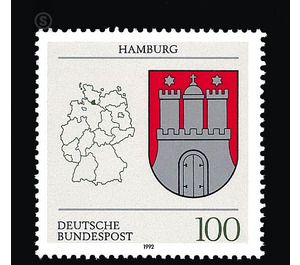Coat of arms of the Land of the Federal Republic of Germany (1) - Germany / Federal Republic of Germany 1992 - 100 Pfennig
Theme: Art & Culture
| Country | Germany / Federal Republic of Germany |
| Issue Date | 1992 |
| Face Value | 100.00 |
| Color | multi-colored white |
| Perforation | K 13 3/4 |
| Printing Type | Multicolor offset printing |
| Stamp Type | Postage stamp |
| Item Type | Stamp |
| Chronological Issue Number | 1464 |
| Chronological Chapter | GER-BRD |
| SID | 523194 |
| In 46 Wishlists | |
The beginnings of Hamburg are in the early 8th century. At this time, Slavic Obotrites settled on the shore (Old Saxon »ham«) of the Alster, not far from the mouth of the river in the Elbe. About a century later, the Hammaburg was built here, the seat of Archbishop Ansgar, the "Apostle of the North." So Hamburg was first city on the Alster. It was not until the 12th century that the Elbe became more important for Hamburg. With the rise of intra-European trade Hamburg developed, not least because of the Barbarossa privilege (1189), to the North Sea port of Lübeck, then the most important city in the western Baltic region. Hamburg played an important, but not dominant role in the Hanseatic League. The Free and Hanseatic City of Hamburg is today, according to its constitution, a country of the Federal Republic of Germany. The national territory covers approximately 755 km2. At the same time, Hamburg is the second largest city in Germany, with around 16 million inhabitants, which carries out a metropolitan function far beyond its borders. Over 2.8 million people live in the Hamburg economic region. The Constitution of the Free and Hanseatic City of Hamburg of 6 June 1952 stipulates in Article 5: »The national colors are white and red. The coat of arms shows the white three-towered castle with a closed gate on a red sign «. This "three-towered castle" of Hamburg bears the main features of the medieval city of the 13th century, when Hamburg's development was the decisive step to detach from the sovereignty of the Holsteiner counts, but the memory of the former significant ecclesiastical task of the archbishopric was still alive. This Hamburg state coat of arms originated from the Hamburg coat of arms, which is known since 1242 from a city seal ago. But probably this seal has existed long before. It shows a stylized representation of a part of the then city fortifications, a section of the city wall with a closed round gate and two defense towers, combined with a different type of central tower. The towers indicate the city's medieval fortification, which enabled its citizens to defend their rights in feuds and wars as if from a castle. A symbol for the defense readiness of the Hamburg citizenry, which had acquired the sovereignty of her sovereign, the count of Holstein. The central tower, a round tower without battlements, which ends in a cross in all city seals to the present, next to the left and right two six-pointed stars are not part of the city fortifications. Similar to other medieval city coats of arms, it points to the most distinguished church building in the city, the Hamburg Cathedral, which was consecrated to Mary, but was demolished at the beginning of the 19th century. The cathedral was a founding of the first archbishop whose seat was later relocated to Bremen. He and his successors were at the same time city lords of the old town of Hamburg until the beginning of the 13th century. Over the centuries, the towers, walls, battlements and symbols of the Hamburg coat of arms were formally changed several times. However, the coat of arms has not changed its character. The use of the city seal with the coat of arms was in ancient times only to the Council. It was a sovereignty over whose observance the city fathers watched attentively. Even today, the coat of arms is protected and may only be used under special conditions. It enjoys the special protection of the Senate. (Text: Senate of the Free and Hanseatic City of Hamburg - Senate Chancellery)


